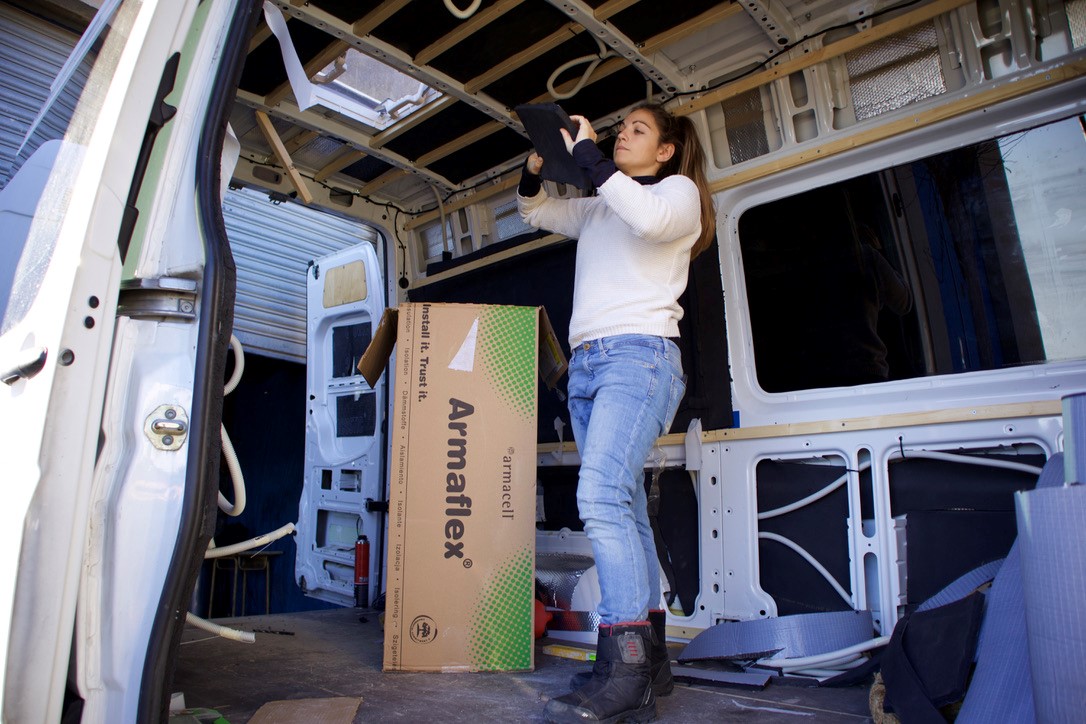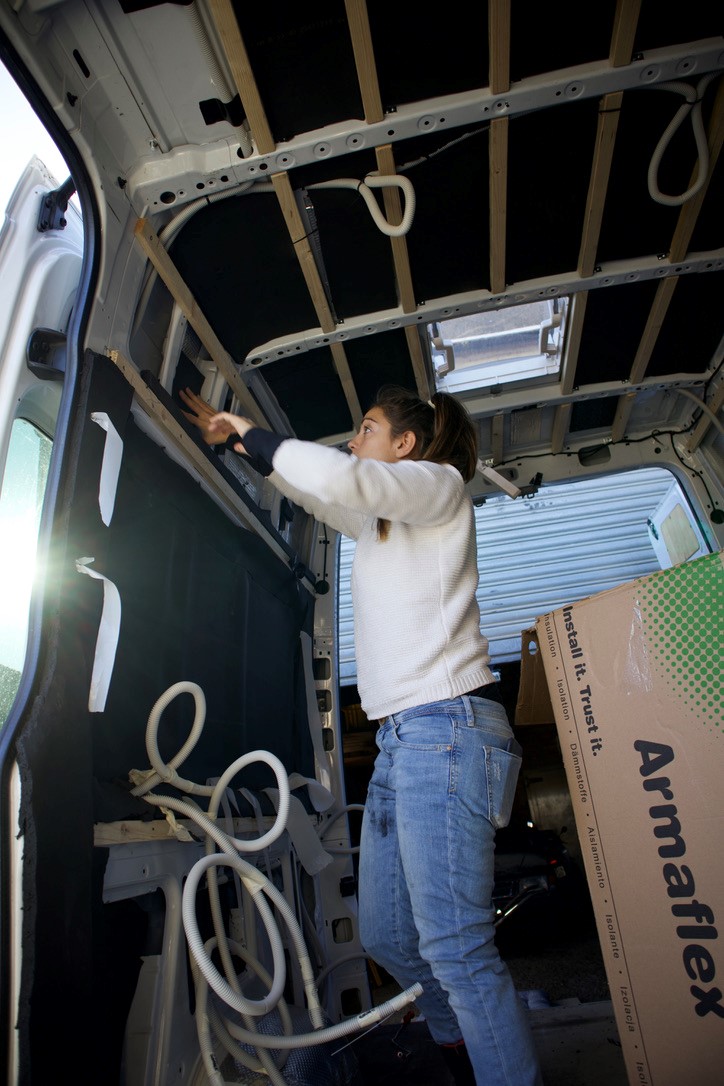Insulating a camper van with Armaflex | Campervan conversion | Van insulation
Christin Busch Reading time approx. 8 minutes
What is the best way to insulate a camper van? Especially in Corona times, the topic of home holidays is booming. Are you also looking for the ideal insulation for your campervan? We show you with this step-by-step guide how to insulate your "dream on wheels" in the best possible way with Armaflex.

Mai from driving_blue insulates with Armaflex; Picture: driving_blu
Why motorhome insulation is important
A motorhome is a home on wheels and you should feel comfortable in it. You breathe, sleep and possibly even shower in your camper. This quickly creates a lot of humidity that needs to be removed. We will explain later which Armaflex best protects against mould growth.
Of course, motorhome insulation is also important so that the heat stays inside in winter and the car doesn't heat up so much in summer. Motorhome insulation also functions as noise insulation. Once you have removed the panelling and partitions, you will notice that the "naked" motorhome is quite audible. Armaflex rubber insulation dampens this annoying background noise and provides extra privacy.
5 reasons why you should insulate your camper van
- Camper heats up much less quickly (summer/warm areas) cold temperatures stay in the camper longer (when the heating is on)
- Heat and heating air can be kept in longer (winter/cooler areas)
- Sound insulation against driving noise and outside noise
- Condensation prevention, which in turn protects against rust
- With integrated mould protection (only with Armaflex AF) you can sleep in your motorhome without health concerns

Insulated van with Armaflex; Image: Dejacamper
Why insulate with Armaflex?
Whether motorhome, campervan or van - the rubber material Armaflex is more popular than any other. The XG and AF variants from the manufacturer Armacell impress with properties such as condensation prevention, easy processing and fire protection class B/BL -s3, d0 (flame retardant). The low thermal conductivity and high water vapour diffusion resistance make the Armaflex an energy-saving solution with an optimal price-performance ratio. In addition, the antimicrobial Microban® finish (only with Armaflex AF) protects against bacteria and mould.
The Armaflex material is very flexible and can be installed in the bodywork in the self-adhesive version simply after removing the adhesive film.
Calculation for your motorhome insulation
Phew, this is where it gets difficult for most people, because of course there are no generally valid quantity specifications. It is also important to know that not all surfaces can be insulated with the same Armaflex variant. For the side walls, ceiling and floor we recommend a 19mm thick Armaflex and additional 6mm or 9mm thick insulation for door elements. The best way to calculate how much material you need for your motorhome conversion is as in this example:
Example: Length 4.30 metres * 1.80 metres width = 7.74 square metres per wall. Since two side walls, the ceiling and the floor are to be insulated, we take the result 7.74 * 4 and get 30.96. In total, we can calculate with approx. 30 sqm Armaflex.
Insulation for your motorhome: variations and quantity
Now we have to subtract the area for the door elements, as not all areas can be insulated with the same variant of Armaflex. Armaflex in insulation thickness 6mm or 9mm is suitable for this.
In addition, joints and transitions should be taped with Armaflex tape (15m/roll), as this eliminates thermal losses. No insulation insulates 100% if the cracks cancel out its function. s
Tip: Do not calculate the insulation materials too tightly, as there will always be waste (no matter how well you work). Nothing is more annoying than not being able to finish the project because a sqm is missing.

Armaflex insulation self-adhesive with cardboard; Photo: Armacell
XG Armaflex board 19 mm self-adhesive
Highly flexible, closed-cell insulation material with high water vapour diffusion resistance and low thermal conductivity.
Euroclass B/BL-s3, d0
Reduction of structure-borne sound transmission by up to 30 dB(A).
Extremely low thermal conductivity (λ 0º = 0.035).
High resistance to water vapour diffusion (µ = 10,000)
AF Armaflex sheet 19mm self-adhesive
Highly flexible, closed-cell insulation material with high water vapour diffusion resistance and low thermal conductivity. With built-in Microban® antimicrobial protection and excellent fire performance, Armaflex AF is the best solution for insulation in cold applications.
In addition, the rubber sheet protects against water vapour penetration due to the integrated, antimicrobial Microban® protection, thus reducing the risk of corrosion under the insulation.
Armaflex AF is self-extinguishing, making it particularly suitable for use in public buildings, process plants and the food industry.
With Microban® antimicrobial finish for additional protection against bacteria and mould growth.
Euroclass B/BL-s3, d0
Reduction of structure-borne sound transmission by up to 30 dB(A)
Extremely low thermal conductivity (λ 0º = 0.033)
High resistance to water vapour diffusion (µ = 10,000).
So, from the above example, the total quantity is as follows:
19 mm Armaflex sheet (6 sqm/carton)= 30 sqm (5 cartons).
9 mm Armaflex sheet (10 sqm)= 10 sqm (1 box)
Armaflex tape (15 m/roll)= 60 m (4 rolls)
Whether XG or AF is up to you. We can recommend both variants for motorhome insulation without hesitation! The small difference in price is due to the higher quality of the AF, which has integrated mould protection.
Both variants (XG and AF) are top in terms of price-performance ratio.
We only advise against the Armaflex ACE, as it emits more vapours and is not self-extinguishing. For these reasons, we do not offer the ACE in our online shop.
What you also need:
- Silicone remover, cloth
- Gloves for protection
- Cutter and/or knife
Insulate box van: Step-by-step instructions
Clean the interior
Before applying the insulation, it is important to clean the walls. Only then will the Armaflex really adhere well later. First remove dirt and dust with a bucket of water and then degrease the walls with a silicone remover.

Side walls and cavities insulated with Armaflex; Image: Dejacamper

Floor of the van is insulated with Armaflex; Photo: Dejacamper
Cutting Armaflex for your camper van
Once the walls have been degreased, you can start with the insulation. We recommend starting with the 19mm thick Armaflex, as the large areas are easier to start with. To do this, measure the surfaces and cut the Armaflex to size with a cutter knife.
Apply the Armaflex to the walls and ceiling
Then hold the cut Armaflex in place and peel off the backing film on one (!) side by a few centimetres. Press the Armaflex against the metal wall while you continue to peel off the backing film. We held the piece of Armaflex against the surface and pulled off the film at one corner (one of the top two) and pressed it against the metal wall there. You can't do much wrong and you'll soon notice that it gets much easier with practice. Save the more difficult areas and cavities for later, until you are more experienced. Gloves are essential here for protection - the metal of the bodywork can be quite sharp.

Camper interior insulated with Armaflex; Image: Dejacamper
Once you have arrived at the side doors, butts and pillars, which to the 9mm thick Armaflex. This is easier to bend and also insulates surfaces that have less clearance. You cut the 9mm Armaflex in the same way and apply it in the usual way.
Then use the Armaflex tape that you need to glue the transitions. In this way, you connect individual blanks and additionally seal the insulation, which prevents thermal losses. The tape is only 3 mm thick and should be usable everywhere.
Motorhome insulation - Timing
Insulating your motorhome is an important part of the conversion. To avoid freezing or sweating on your travels, you should allow enough time for the insulation work. Depending on the size of your camper, you should allow a weekend. Especially the insulation of the many cavities takes time.
Have fun with your project!

Mai insulates cavities of her camper with Armaflex; Picture: driving_blu







